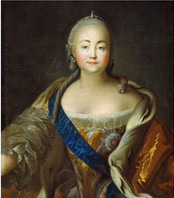
As a result of palace revolution Elisabeth Petrovna began her rule in Russia
On the night of November 25 (December 6) 1741 in Russia took place a palace revolution and the power seized the daughter of Peter I and Catherine I, Elisabeth, who had ruled the country for 20 years.
For 18th century the palace revolutions were not rare. Their sources hid in the ruling power weakness: due to the violation of the throne inheritance in the male line, the rule of the country often happened to be in the regents’ hands who aspired to become a rightful monarch. This was precisely the case in Russia after the death of Anna Ioanovna.
Under the empress will the throne inherited her grand-nephew, the juvenile Ioann Antonovich, with a regent E.J. Biron to assist him. But a few days later the mother of the heir, Anna Leopoldovna, removed Biron and became a regent herself. It is known that she had been preparing a new law on the inheritance of the throne expecting to become an empress by her birthday, December 7 (18). For the sake of this goal she tried to enlist the support of the broad sections of the public distributing privileges and grants that weakened the country. However in the autumn of 1741 the discontent with Braunschweig dynasty started to build up. The nobility was indignant with the order of conferring the ranks that were given by the empress’ caprice. The guard grumbled about the drill and punishments growth that the power applied trying to reestablish order in the army. The order to send the guard regiments located in the capital to the theater in Finland became the last straw that led the soldiers under the banners of Princess Elisabeth.
These were the guard lower strata and not the officers, as in other analogue situations, who became the main force of the revolution of 1741. Elisabeth intended to involve the guard in only as a last resort understanding how dangerous it might be to involve the troops in political struggle. She tried to obtain support from Europe and had been holding negotiations with the representatives of France and Sweden trying to convince them that she had a great number of followers among the Russian nobility. However the foreign members of the intrigue were not generous enough to provide her with the means to realize her plot because Elisabeth was prudent and did not give them any promises that could harm her country in case she won. Moreover the actions of the Sweden troops turned out to be unsuccessful so the princess could count only on domestic forces.
Having talked to Anna Leopoldovna who was not content that her cousin communicated with the French and Swedish ambassadors, Elisabeth decided to force the events. Having obtained the consent of Semenov regiment grenadiers who were on guard, on the night of November 25 (December 6) she personally went to Preobrazhensky regiment’s quarters to lead the soldiers. Peter I daughter was supported by the majority of the non-commissioned officers who were selected for the model company by the prince Antoine-Ulrich Braunschweig himself. Having taking the oath to a new empress, the grenadiers led by the gentleman of the monarch’s bad chamber M.I. Vorontzov and doctor I. Lestok went to the Winter Palace and arrested the ruling family.
The revolution was fast and bloodless. The deposed Ioann Antonovich spent all his life in prison and was killed in 1764 at the attempt to be freed in order to bring into force another palace plot.
The Preobrazhensky regiment company that had realized the revolution was renamed into a life-company. The captain became the empress herself. All the ranks received the noble titles and estates, and the officers received new ranks and gifts.
Elisabeth’s twenty years epoch began in Russia.
Lit.: Анисимов Е. В. Дворцовые тайны. М., 2007; Курукин И. В. Дворцовый переворот 1741 года: причины, «технология», уроки // Отечественная история. 1997. № 5.
Based on the Presidential Library’s materials:

